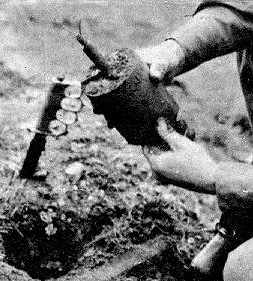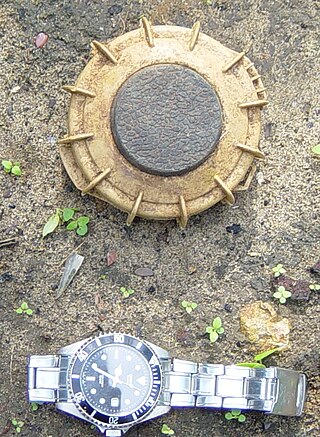
A tripwire is a passive triggering mechanism. Typically, a wire or cord is attached to a device for detecting or reacting to physical movement.

A tripwire is a passive triggering mechanism. Typically, a wire or cord is attached to a device for detecting or reacting to physical movement.
Such tripwires may be attached to one or more mines — especially fragmentation or bounding mines — in order to increase the area where triggering may occur. Trip wires are frequently used in booby traps — where either a tug on the wire, or the release of tension on it, will trigger the explosives.
Soldiers sometimes detect the presence of tripwires by spraying the area with Silly String. It will settle to the ground in areas where there are no wires; where wires are present, the "strings" will rest on the taut wires without triggering the explosive, due to the product's light weight. Its use in detecting tripwires was first discovered in 1993 by Sergeant First Class David B. Chandler, Chief Instructor of the United States Army's Sapper Leader Course. That year it was introduced to students attending the course, and it was later used in combat for this purpose by U.S. troops in the Iraq War. [1] [2] [3]
Another detection method is the use of green line lasers to illuminate and thus expose trip and command wires. The bright laser beam reflects off the tripwire and can be seen by the user.
A tripwire may be installed in the vicinity of industrial equipment, such as a conveyor belt to enable workers to stop the equipment quickly. [4] These may also be called emergency stop pull-cords. [5]

A land mine, or landmine, is an explosive weapon concealed under or camouflaged on the ground, and designed to destroy or disable enemy targets, ranging from combatants to vehicles and tanks, as they pass over or near it.

The Claymore mine is a directional anti-personnel mine developed for the United States Armed Forces. Its inventor, Norman MacLeod, named the mine after a large medieval Scottish sword. Unlike a conventional land mine, the Claymore may be command-detonated, and is directional, shooting a wide pattern of metal balls into a kill zone. The Claymore can also be activated by a booby-trap tripwire firing system for use in area denial operations.

A conveyor belt is the carrying medium of a belt conveyor system. A belt conveyor system is one of many types of conveyor systems. A belt conveyor system consists of two or more pulleys, with a closed loop of carrying medium—the conveyor belt—that rotates about them. One or both of the pulleys are powered, moving the belt and the material on the belt forward. The powered pulley is called the drive pulley while the unpowered pulley is called the idler pulley. There are two main industrial classes of belt conveyors; Those in general material handling such as those moving boxes along inside a factory and bulk material handling such as those used to transport large volumes of resources and agricultural materials, such as grain, salt, coal, ore, sand, overburden and more.
The GATOR mine system is a United States military system of air-dropped anti-tank and anti-personnel mines developed in the 1980s to be compatible with existing cluster dispensers. It is used with two dispenser systems—the Navy 230 kg (500 lb) CBU-78/B and the Air Force 450 kg (1,000 lb) CBU-89/B. Additionally the mines are used with the land- and helicopter-based Volcano mine system.

A booby trap is a device or setup that is intended to kill, harm or surprise a human or another animal. It is triggered by the presence or actions of the victim and sometimes has some form of bait designed to lure the victim towards it. The trap may be set to act upon trespassers that enter restricted areas, and it can be triggered when the victim performs an action. It can also be triggered by vehicles driving along a road, as in the case of improvised explosive devices (IEDs).

An improvised explosive device (IED) is a bomb constructed and deployed in ways other than in conventional military action. It may be constructed of conventional military explosives, such as an artillery shell, attached to a detonating mechanism. IEDs are commonly used as roadside bombs, or homemade bombs.

A residual-current device (RCD), residual-current circuit breaker (RCCB) or ground fault circuit interrupter (GFCI) is an electrical safety device that interrupts an electrical circuit when the current passing through a conductor is not equal and opposite in both directions, therefore indicating leakage current to ground or current flowing to another powered conductor. The device's purpose is to reduce the severity of injury caused by an electric shock. This type of circuit interrupter cannot protect a person who touches both circuit conductors at the same time, since it then cannot distinguish normal current from that passing through a person.

The German S-mine, known by enemy Allied Forces as the "Bouncing Betty" on the Western Front and "frog-mine" on the Eastern Front, is the best-known version of a class of mines known as bounding mines. When triggered, these mines are launched into the air and then detonated at about one metre (3 ft) from the ground. The explosion projects a lethal spray of shrapnel in all directions. The S-mine was an anti-personnel mine developed by Germany in the 1930s and used extensively by German forces during World War II. It was designed to be used in open areas against unshielded infantry. Two versions were produced, designated by the year of their first production: the SMi-35 and SMi-44. There are only minor differences between the two models.

Demining or mine clearance is the process of removing land mines from an area. In military operations, the object is to rapidly clear a path through a minefield, and this is often done with devices such as mine plows and blast waves. By contrast, the goal of humanitarian demining is to remove all of the landmines to a given depth and make the land safe for human use. Specially trained dogs are also used to narrow down the search and verify that an area is cleared. Mechanical devices such as flails and excavators are sometimes used to clear mines.

Silly String is a toy of flexible, sometimes brightly colored, plastic string propelled as a stream of liquid from an aerosol can. The solvent in the string quickly evaporates in mid-air, creating a continuous strand. Silly String is often used during weddings, birthday parties, carnivals and other festive occasions, and has also been used by the US military to detect tripwires.

The M16 mine is a United States-made bounding anti-personnel mine. It was based on captured plans of the World War II era German S-mine and has similar performance.

An anti-personnel mine or anti-personnel landmine (APL) is a form of mine designed for use against humans, as opposed to an anti-tank mine, which target vehicles. APLs are classified into: blast mines and fragmentation mines; the latter may or may not be a bounding mine.

The PROM-1 is a Yugoslavian manufactured bounding anti-personnel mine. It consists of a cylindrical body with a pronged fuze inserted into the top of the mine. It is broadly similar in operation to the German S-mine.
The NR-413 is a Belgian trip wire activated anti-personnel stake mine. The main body of the mine is wine bottle shaped, with an NR 410 tripwire fuse screwed into a fuse well on the top of the mine. Under the fuse well is a detonator and a row of booster pellets. Wrapped around the detonator and booster pellets is the main charge. An internally square cross-sectioned steel wire is coiled around the outside of the mine, which give a fragmentation effect. The mine produces 600 fragments with a velocity of approximately 1,660 metres per second. It has an effective range of around 15 metres. A variant is produced with a cast steel fragmentation jacket.

Curb feelers or curb finders are springs or wires installed on a vehicle that act as "whiskers" to alert drivers when they are at the right distance from the curb while parking.
The BM/85 is an Italian blast resistant bounding anti-personnel mine that was produced by Tecnovar italiana SpA. The mine is cylindrical with a three pronged tilt/pressure fuze on the top with a central post for attaching a tripwire. A plastic safety clip prevents the fuze from tilting when in transit. Once the pressure clip is removed the mine is armed. Once the fuze is pulled sideways by a trip wire or by downward pressure, the mine is triggered. A small charge launches the mine to a height of about 0.45 meters where it explodes scattering 1,000 fragments to a lethal radius of about 25 meters.
The M432 is a Portuguese bounding anti-personnel mine, which traces the roots of its design to the Second World War German S-mine, although it is probably more directly related to the Belgian NR 442 mine and United States M16 mine. As of 2004, all operational stocks of the mine have been destroyed, although some may have been retained for training purposes.

A tripflare is a device used by military forces to secure an area and to guard against infiltration. It consists of tripwire around the area, linked to one or more flares. When the tripwire is triggered, as by someone unsuspectingly disturbing it, the flare is activated and begins burning. The light from the flare simultaneously warns that the perimeter may have been breached and also gives light for investigating. In defensive operations, tripflares are usually placed in predetermined kill zones with machine guns sighted on them.

Counter-IED equipment are created primarily for military and law enforcement. They are used for standoff detection of explosives and explosive precursor components and defeating the Improvised Explosive Devices (IEDs) devices themselves as part of a broader counter-terrorism, counter-insurgency, or law enforcement effort.

The A.P. (anti-personnel) Shrapnel Mine is a British bounding mine of World War II.
The conveyor trip switch, is a safety switch that has a pretension device which allows the trip wire to be tensioned.